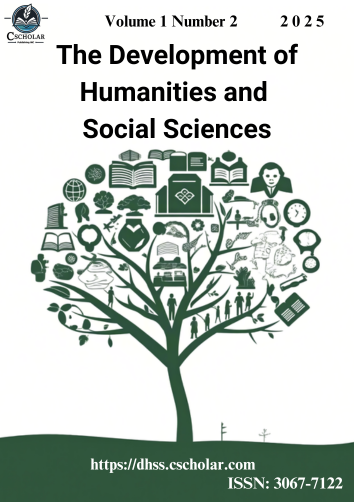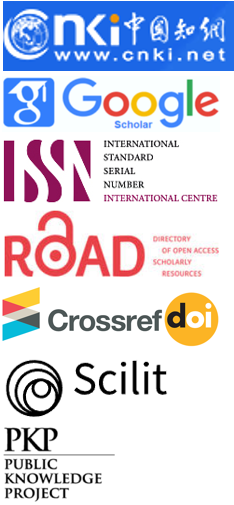Intergenerational Mobility and Regional Differentiation in China's Population Structure, 2010–2020
DOI:
https://doi.org/10.71204/nysvds90Keywords:
Intergenerational, Population Pattern, EvolutionAbstract
The 20th National Congress of the Communist Party of China emphasizes promoting coordinated regional development and advancing a new type of urbanization centered on people. To better understand the evolution of the population pattern and the mechanisms behind it, GIS statistical analysis and mathematical statistical analysis were used. Combined with the data from the sixth national census in 2010 and the seventh national census in 2020, it was found that the overall trend of population growth was mainly concentrated in the eastern developed provinces such as Beijing and Shanghai, Jiangsu Province, Zhejiang Province and Guangdong Province. There was also a significant increase in resource-based provinces such as Xinjiang Uygur Autonomous Region and Tibet Autonomous Region, while the population in less developed provinces such as Henan Province, Gansu Province, the three northeastern provinces and Inner Mongolia Autonomous Region decreased significantly. The notable changes in the population pattern of the post-80s and post-70s generations are that some of them are moving out of Beijing and Shanghai, where the cost of living is high, and the post-60s generation is moving in to Sichuan and Chongqing. By group, young people with high knowledge mainly move to first-tier cities, but also to second-tier cities due to factors such as high housing prices and high living costs; Young ordinary college students are mainly concentrated in second-tier cities or positions within the system at all levels of counties and cities; Urban basic blue-collar workers are more likely to move to the local big cities; Older migrant workers are gradually returning to their hometowns to retire; The general living population in the central and western regions: all want to move to provincial capitals; The number of "new farmers" moving to the countryside is increasing. In light of the flow patterns of different age groups and groups, this article puts forward policy suggestions from aspects such as strengthening the training of professional and technical talents, attaching importance to grassroots elderly care and making large and medium-sized cities "fertility-friendly", and formulating development strategies based on local conditions to promote sustainable development of people and society.
References
Bagen, D. J. (1966). Principle of Demography.Journal of the Royal Statistical Society, 19(4), 410.
Cai, S., Xu, D., Liu, C.(2024). Spatial Differentiation of Influencing Factors on Settlement Intention of Floating Population in the Yangtze River Delta. World Regional Studies , 33, 106-119.
Chen, M., Wu, Y., Liu, G., et al. (2020). City economic development, housing availability, and migrants' settlement intentions: Evidence from China. Growth and Change, 51(3), 1239-1258.
Chen, S., Zhou, R., Gao, J. (2020). Temporal and Spatial Characteristics of Spring Festival Population Flow in the Yangtze River Delta Urban Agglomeration Based on Tencent Migration Big Data. Human Geography, 35, 130-138.
Duan, C., Qiu, Y. (2023). The Latest Trends and Governance Transformation of Population Mobility Under China’s Migration Transition Pattern. Journal of the Party School of the Central Committee of the C.P.C (National Academy of Governance) , 27, 118-129.
Gu, H., Lao, X., Wen, F., Zhao, Z. (2022). Evolution Characteristics and Influencing Factors of the Inter-provincial Population Migration Pattern in China from 2000 to 2020. Acta Geographica Sinica , 77, 3041-3054.
Huang, Z., Zhen, F., Xi, G., Li, Z. (2023). Structural Characteristics and Influencing Factors of Daily Population Mobility Networks in Nanjing Metropolitan Area. Human Geography, 38, 112-120.
Jin, T., Rui, Y., Lin, J., Wang, L., Luo, F. (2024). Micro-scale Study on the Patterns and Driving Mechanisms of Population Outflow in Traditional Villages in Southeast Coastal China. Geography and Geo-Information Science, 40, 99-105+113.
Ke, W., Zhu, Y., Chen, C., Guy, J.A., Lin, L., Lin, J. (2022). Temporal and Spatial Variation Characteristics of China's Population Migration from 1995 to 2015. Acta Geographica Sinica, 77, 411-425.
Lai, J., Zhu, J., Guo, Y., You, J., Xie, Y., Fu, L., Wang, P. (2023). Spatial Pattern and Network Structure Resilience of Population Mobility in the Central Plains Urban Agglomeration. Geography and Geo-Information Science, 39, 55-63.
Lao, X., Gu, H., Lu, L. (2023). The Pattern of Inter-provincial Population Migration and Changes in Influencing Factors between Two Population Censuses. Population and Development, 29, 15-30.
Lao, X., Gu, H., Lu, L., Wang, S, Wen, F. (2023). Changes in Interprovincial Migration Patterns and Determinants Between Two Censuses. Population and Development, 29, 15-30.
Lee, E. S. (1966). A theory of migration. Demography, 3, 47-57.
Li, Q., Yang, C. (2025). Pathways and Policy Innovations for Cultivating "New Farmers" in the New Era. China Agricultural Education, 26, 27-38.
Lin, L., Zhu, Y. (2022). Types and determinants of migrants' settlement intention in China's new phase of urbanization: A multi-dimensional perspective. Cities, 124, 103622.
Liu, T., Wang, J. (2020). Bringing city size in understanding the permanent settlement intention of rural–urban migrants in China. Population, Space and Place, 26, e2295.
Liu, T., Wang, J. (2020). Bringing city size in understanding the permanent settlement intention of rural–urban migrants in China. Population, Space and Place, 26(4), e2295.
Liu, Y., Deng, W., Song, X. (2018). Influence factor analysis of migrants' settlement intention: Considering the characteristic of city. Applied Geography, 96: 130-140.
Lu, C., Xi, X., Wang, J., Yan, B. (2023). Spatial Characteristics and Influencing Factors of Rural Population Mobility in Former Deep Poverty-stricken Areas in the Post-poverty-alleviation Era: A Case Study of the Integrated Development Area of "One City and Three Counties" in Liangshan Prefecture. Journal of China Agricultural University, 28, 229-243.
Lu, L., Yin, S. (2023). Modeling Interprovincial Population Flows in China Based on Spatial Interaction Theory. Population & Economics, 5, 126-140.
Sjaastad, L. A. (1962). The costs and returns of human migration. Journal of political Economy, 70(5, Part 2), 80-93.
Song, Y., Zhang, C. (2020). City size and housing purchase intention: Evidence from rural–urban migrants in China. Urban Studies, 57(9), 1866-1886.
Stark, O., Bloom, D. E. (1985). The new economics of labor migration. The american Economic review, 75(2), 173-178.
Stark, O., Taylor, J. E. (1989). Relative deprivation and international migration oded stark. Demography, 26(1), 1-14.
Tong, D., Zhang, H., Ying, R. (2023). Equalization of Basic Public Services, Urban Integration, and Migrant Workers’ Settlement Intentions. Journal of Agrotechnical Economics, 10, 79-94.
Wang, J., Zhang, M., Wang, N. (2023). The Spatial Pattern and Influencing Factors of the Distribution of Floating Population in China: A Study Based on the County-level Data of the Population Census. Population Journal , 45, 82-96.
Wang, X., Qi, W., Liu, S., et al. (2022). The settlement intention of urban-to-urban migrants in China: Spatial differences and driving factors. Journal of Geographical Sciences, 32(12), 2503-2524.
Xiao, J., Hong, H. (2020). Evolution Trends of Interprovincial Population Flow Patterns and Their Urbanization Effects in China. Urban Problems, 8, 22-32.
Xiao, Z., Guo, G. (2021). Coordinated Evolution of Population, Economy and Environment in the Yangtze River Delta Region. Environmental Science & Technology, 44, 196-205.
Xu, L., Wu, J., Pang, L. (2023). Spatiotemporal Evolution and Influencing Factors of Floating Population in Chinese Cities at Prefecture Level and Above. Population and Development, 29, 89-99.
Xu, Q., Wang, Y. (2022). The Spatial Pattern of China’s Ethnic Minority Floating Population and Its Influencing Factors: An Analysis Based on Prefecture-Level Data from the 2010 Census. Population and Development , 28, 50-58+49.
Xue, C., Wang, L., Chang, F. (2020). Temporal and Spatial Characteristics and Influencing Factors of the Floating Population in Chinese Cities. Areal Research and Development, 39, 157-162.
Xue, C., Wang, L., Chang, F. (2020). Temporal and Spatial Characteristics and Influencing Factors of the Floating Population in Chinese Cities. Areal Research and Development, 39, 157-162.
Yu, W., Lu, X., Wang, E. (2020). Rural land reforms and villagers' preferences for urban settlement: A case study of Shandong Province, China. Growth and Change, 51(3), 1259-1276.
Zeng, Y., Zhong, Z., Liu, H. (2023). The Pattern Transition and Driving Mechanism of China's Inter-provincial Population Flow from a Network Perspective: 1991-2020. China Population, Resources and Environment, 33, 160-170.
Zhang, Q., Mei, Y. (2020). A Study on the "Counter-urbanization" Trend and Influencing Factors of the Population Spatial Distribution in the Yangtze River Economic Belt. Journal of Central China Normal University (Humanities and Social Sciences), 59, 43-53.
Zhang, Y., Wang, Y., Hu, H., Yuan, C. (2023). Spatiotemporal Distribution and Mobility Characteristics of Population in Beijing-Tianjin-Hebei Urban Agglomeration Based on Mobile Phone Signaling Big Data. Areal Research and Development, 42, 161-167+180.
Downloads
Published
Data Availability Statement
The original data presented in the study are openly available in CMDS at https://www.ncmi.cn.
Issue
Section
Categories
License
Copyright (c) 2025 Jinchuan Huang , Junjuan Wang (Author)

This work is licensed under a Creative Commons Attribution 4.0 International License.
All articles published in this journal are licensed under the Creative Commons Attribution 4.0 International License (CC BY 4.0). This license permits unrestricted use, distribution, and reproduction in any medium, provided the original author(s) and source are properly credited. Authors retain copyright of their work, and readers are free to copy, share, adapt, and build upon the material for any purpose, including commercial use, as long as appropriate attribution is given.





